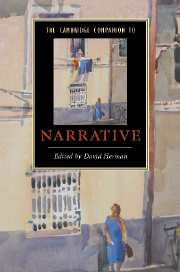Book contents
- Frontmatter
- Part I Preliminaries
- Part II Studying narrative fiction: a starter-kit
- Part III Other narrative media (a selection)
- 9 Conversational storytelling
- 10 Drama and narrative
- 11 Film and television narrative
- 12 Narrative and digital media
- Part IV Further contexts for narrative study
- Glossary
- Further reading
- Index
11 - Film and television narrative
from Part III - Other narrative media (a selection)
Published online by Cambridge University Press: 28 September 2007
- Frontmatter
- Part I Preliminaries
- Part II Studying narrative fiction: a starter-kit
- Part III Other narrative media (a selection)
- 9 Conversational storytelling
- 10 Drama and narrative
- 11 Film and television narrative
- 12 Narrative and digital media
- Part IV Further contexts for narrative study
- Glossary
- Further reading
- Index
Summary
Narrative theory is a flexible tool, useful for analyzing elements of storytelling common across a wide range of media. A detailed vocabulary for the mechanics of plotting or elements of characterization can help us understand a novel, television show, comic book, videogame, film, opera, or any other form of storytelling. Although the concepts explored in this collection can be applied productively to any medium, we must also be aware of the ways that any specific medium creates particular storytelling parameters, constraining some options while enabling others. Thus the goal of this chapter is to outline some of the specific narrative facets that are common to moving-image storytelling as found within film and television, and to explore how these two media function as major narrative forms in contemporary culture.
Film and television share a common visual and aural form, and thus many of their specific storytelling practices are similar; however, the two media diverge in crucial ways, with sufficiently different structures that we cannot analyze film and television narratives identically. By examining these media comparatively, we can see how film and television differ from literature in areas such as narration, perspective, temporality, and comprehension, and diverge from each other regarding plot structures and viewer engagement. To explore aspects of moving-image narration and to exemplify the particular ways that film and television narratives function, this chapter explores two popular examples: the film of The Wizard of Oz; and the television series Lost.
- Type
- Chapter
- Information
- The Cambridge Companion to Narrative , pp. 156 - 171Publisher: Cambridge University PressPrint publication year: 2007
- 10
- Cited by

